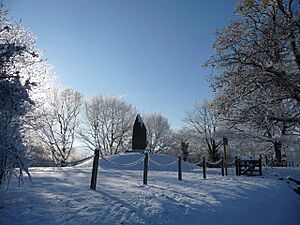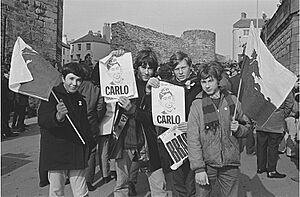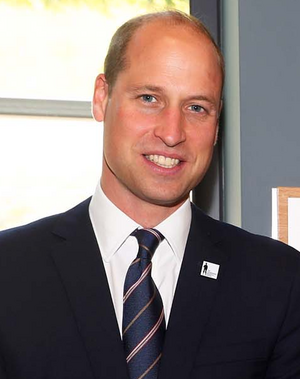Prince of Wales facts for kids
Quick facts for kids Prince of Wales |
|
|---|---|

|
|
| Style | His Royal Highness Sir |
| Residence | Adelaide Cottage, England |
| Appointer | Sovereign of the United Kingdom |
| Term length | Life tenure or until accession as Sovereign |
| Formation | 1301 |
| Website | www.princeofwales.gov.uk |
The Prince of Wales (Welsh: Tywysog Cymru in Welsh, Latin: Princeps Cambriae/Walliae in Latin) is a special title. Long ago, it was used by independent Welsh leaders. Since the 14th century, it has been given to the person who is next in line to become the King or Queen of England, and later, Britain.
Historically, Welsh princes held this title before the 12th century. It replaced the word "king" for their rulers. The first person to be called Prince of Wales was Gruffudd ap Cynan of Gwynedd in 1137. His son, Owain Gwynedd, is often seen as the one who truly made the title important. Llywelyn the Great was a very strong leader. He ruled most of Wales for 45 years.
One of the last native Princes of Wales was Llywelyn ap Gruffudd, also known as Llywelyn the Last. He was killed in 1282 during the Battle of Orewin Bridge. His brother, Dafydd ap Gruffydd, was executed the next year. These events ended Welsh independence.
After these deaths, Edward I of England gave the title "Prince of Wales" to his own son, Prince Edward. This Prince Edward was born in Caernarfon Castle in 1284 and received the title in 1301. He was the first English Prince of Wales. Later, Owain Glyndŵr, a Welsh leader, claimed the title from about 1400 to 1415. He led Welsh forces against the English. Since then, only the heir to the English, and later British, throne has held the title.
The English (and later British) Prince of Wales title is not passed down automatically. It joins with the Crown when the prince becomes king. Since 1301, the title Earl of Chester has also been given along with Prince of Wales. The Prince of Wales often has other titles too, like Duke of Cornwall. Unlike the Prince of Wales title, being Duke of Cornwall comes with land and duties. The title is usually given to the monarch's eldest son or grandson who is the heir. On September 8, 2022, the title became part of the Crown when Prince Charles became King after his mother, Elizabeth II, passed away. The next day, King Charles III gave the title to his son, Prince William.
Some people in Wales have not supported the use of the "Prince of Wales" title for non-Welsh heirs. When Charles was invested, there were protests. When William was named Prince of Wales by King Charles, two thousand Welsh people signed a petition against it.
Early Welsh Princes
| Prince of Wales | |
|---|---|

Arms of Owain Lawgoch and Owain Glyndwr as Prince of Wales
|
|

Arms of Kingdom of Gwynedd and of Gwynedd Princes of Wales
|
|
|
Statue of Owain Glyndwr
|
|
| First holder | Gruffudd ap Cynan ("Prince of the Welsh") |
| Final holder | Owain Glyndwr |
Before the title "King or Prince of Wales" was used, leaders in Wales were sometimes called "King of the Britons." This title described the king of the Celtic Britons, who were the ancestors of the Welsh people.
Many Welsh leaders claimed to be "King of Wales." Some even ruled most of Wales. However, the entire area of modern-day Wales was only united under one ruler, Gruffydd ap Llywelyn, from 1055 to 1063. He was called King of Wales by some historians. He was the last British ruler to be called "King of the Britons." By this time, Wales was the only part of Britain still ruled by the Brittonic people.
The title "Prince of Wales" became more common around the 11th century. It was a new way to describe the old high kingship of the Britons. The princes of the Middle Ages mostly came from west Wales, especially Gwynedd. They had great power, which allowed them to claim control over all of Wales.
The End of Native Welsh Princes
Llywelyn ap Gruffudd (Llywelyn the Last), who was the last native Prince of Wales, was killed in 1282. His brother, Dafydd ap Gruffydd, was executed in 1283 by King Edward I of England. These events effectively ended Welsh independence. After this, the English monarchy started using the title Prince of Wales for the heir to their own throne.
Rival Princes of Wales
Between 1400 and 1413, there were two people claiming to be Prince of Wales. One was the native Welsh leader, Owain Glyndŵr. The other was the English Prince of Wales, who later became Henry V of England. Owain Glyndwr led Welsh forces in a rebellion against English rule.
Welsh Symbols and Arms
Llywelyn the Last's Arms

The three native Princes of Wales used the arms (symbols) of the House of Gwynedd. This family line is divided into two parts: the earlier House of Cunedda (from about 420–825) and the later House of Aberffraw (starting in 844). The Aberffraw line, which included Llywelyn the Great, ended when Owain Lawgoch died in 1378.
Owain Glyndwr's Arms
Owain Glyndwr changed the House of Gwynedd arms. He made the lions "rampant" (standing on their hind legs). This showed his connection to the princes of Gwynedd and Llywelyn ap Gruffydd. It also showed his fight for Wales. His design may have been influenced by the arms of other Welsh regions. Glyndwr's arms were used as a banner in battles against the English. This banner is a symbol of Welsh strength and protest.
The Prince of Wales as Heir to the Throne
Since 1301, the Prince of Wales has usually been the eldest living son of the King or Queen of England (later Great Britain and the United Kingdom). This son must also be the heir apparent, meaning he is next in line for the throne. For example, when Prince Arthur died, his younger brother Henry (who became Henry VIII) was given the title. Also, when Frederick, Prince of Wales died, his son George (who became George III) was made Prince of Wales.
The title is not automatically inherited. It merges with the Crown when the prince becomes king. Or, it ends if the prince dies. Then, the monarch can give the title to the new heir. For example, Prince Charles became Prince of Wales in 1958 when he was nine. He was formally invested (given the title in a ceremony) eleven years later in 1969.
William Camden, a historian, wrote about the start of the English Prince of Wales title. He explained that after Llywelyn ap Gruffydd was killed, King Edward I joined Wales to the Kingdom of England. The people of Wales then swore loyalty to Edward's son, Edward of Caernarvon, whom he made Prince of Wales.
The United Kingdom agreed in 2011 to change the rules about who inherits the throne. These changes mean that the oldest child, regardless of gender, will inherit. This new rule came into effect in 2015.
Titles and Roles of the Prince of Wales
Since 1301, the title Earl of Chester has been given to each heir to the English throne who is also Prince of Wales. Both titles are given by the monarch and are not automatically received. The Duchy of Cornwall was created in 1337. It ensures that the eldest heir to the English throne also becomes the Duke of Cornwall.
The Prince of Wales is traditionally the heir to the monarch of the United Kingdom. There is no official law or duty given to him by Parliament. However, the Prince of Wales often helps the monarch with their duties. For example, before he became King, Charles would represent the Queen. He would welcome important visitors and attend state dinners. He also represented the UK overseas at important events like state funerals. The Prince of Wales can also issue royal warrants, which are special permissions given by the monarch.
British Royal Symbols
As the heir to the monarch, the Prince of Wales uses the Royal Arms. These arms have a small white label with three points added to show he is the heir. To represent Wales, he also has the Coat of Arms of the Principality of Wales on a small shield in the middle. This badge is topped with the heir apparent's crown. This was first used by King Edward VIII in 1910, and then by King Charles III when he was Prince of Wales.
The symbol of the three ostrich feathers is the badge of the Duke of Cornwall, or the heir to the British throne. This symbol is usually linked to Edward, the Black Prince (1330–1376). He was the eldest son and heir of King Edward III of England. The Black Prince used a shield with three silver ostrich feathers on a black background. This was called his "shield for peace," likely used for jousting. These arms can be seen on his tomb in Canterbury Cathedral. The Black Prince also used badges with one or more ostrich feathers in other ways.
Opposition to the Title

The ceremony where Charles was invested as Prince of Wales was controversial. It led to many protests. On the day of the investiture, some peaceful protesters were arrested.
In 2021, a group called Republic put up billboards in Wales. These billboards called for the end of the monarchy. They said in both Welsh and English that "Wales doesn't need a prince." This referred to Charles at the time.
In 2022, after Queen Elizabeth II died, a Welsh politician named Lord Dafydd Elis-Thomas said the title "doesn't make any sense." A petition asking for the Prince of Wales title to end received thousands of signatures very quickly after the title became vacant.
Public Opinion
A BBC Wales poll in 1999 found that 73 percent of Welsh speakers wanted the position of Prince of Wales to continue.
Another BBC poll in 2009, marking 40 years since Charles's investiture, showed that 38 percent of Welsh people supported a similar public ceremony for Prince William when Prince Charles became king.
A poll in July 2018 found that 57% of Welsh people supported the title being passed on when the current prince becomes king. 27% were against it. Support for a similar investiture ceremony was less clear, with 31% supporting it, 27% against it, and 18% wanting a different kind of ceremony.
List of Princes of Wales (English or British Heirs)
| Person | Name | Heir of | Birth | Became heir apparent | Created Prince of Wales | Ceased to be Prince of Wales | Death |
|---|---|---|---|---|---|---|---|
 |
Edward of Carnarvon | Edward I | 25 April 1284 | 19 August 1284 | 7 February 1301 | 7 July 1307 acceded to throne as Edward II |
21 September 1327 |
| Edward of Woodstock, the Black Prince | Edward III | 15 June 1330 | 12 May 1343 | 8 June 1376 deceased |
|||
 |
Richard of Bordeaux | 6 January 1367 | 8 June 1376 | 20 November 1376 | 22 June 1377 acceded to throne as Richard II |
14 February 1400 | |
 |
Henry of Monmouth | Henry IV | 16 September 1386 | 30 September 1399 | 15 October 1399 | 21 March 1413 acceded to throne as Henry V |
31 August 1422 |
 |
Edward of Westminster | Henry VI | 13 October 1453 | 15 March 1454 | 11 April 1471 father deposed |
4 May 1471 deceased |
|
 |
Edward of York | Edward IV | 4 November 1470 | 11 April 1471 | 26 June 1471 | 9 April 1483 acceded to throne as Edward V |
1483? |
 |
Edward of Middleham | Richard III | 1473 | 26 June 1483 | 24 August 1483 | 31 March or 9 April 1484 deceased |
|
 |
Arthur Tudor | Henry VII | 20 September 1486 | 29 November 1489 | 2 April 1502 deceased |
||
 |
Henry Tudor | 28 June 1491 | 2 April 1502 | 18 February 1504 | 21 April 1509 acceded to throne as Henry VIII |
28 January 1547 | |
 |
Edward Tudor | Henry VIII | 12 October 1537 | – | 28 January 1547 acceded to throne as Edward VI |
6 July 1553 | |
 |
Henry Frederick Stuart | James I | 19 February 1594 | 24 March 1603 | 4 June 1610 | 6 November 1612 deceased |
|
 |
Charles Stuart | 19 November 1600 | 6 November 1612 | 4 November 1616 | 27 March 1625 acceded to throne as Charles I |
30 January 1649 | |
 |
Charles Stuart | Charles I | 29 May 1630 | declared c. 1638–1641 | 30 January 1649 title abolished; later (1660) acceded to throne as Charles II |
6 February 1685 | |
 |
James Francis Edward Stuart | James II | 10 June 1688 | c. 4 July 1688 | 11 December 1688 father deposed |
1 January 1766 | |
 |
George Augustus | George I | 10 November 1683 | 1 August 1714 | 27 September 1714 | 11 June 1727 acceded to throne as George II |
25 October 1760 |
 |
Frederick Louis | George II | 1 February 1707 | 11 June 1727 | 8 January 1729 | 31 March 1751 deceased |
|
 |
George William Frederick | 4 June 1738 | 31 March 1751 | 20 April 1751 | 25 October 1760 acceded to throne as George III |
29 January 1820 | |
 |
George Augustus Frederick | George III | 12 August 1762 | 19 August 1762 | 29 January 1820 acceded to throne as George IV |
26 June 1830 | |
 |
Albert Edward | Victoria | 9 November 1841 | 8 December 1841 | 22 January 1901 acceded to throne as Edward VII |
6 May 1910 | |
 |
George Frederick Ernest Albert | Edward VII | 3 June 1865 | 22 January 1901 | 9 November 1901 | 6 May 1910 acceded to throne as George V |
20 January 1936 |
 |
Edward Albert Christian George Andrew Patrick David | George V | 23 June 1894 | 6 May 1910 | 23 June 1910 | 20 January 1936 acceded to throne as Edward VIII; later (1937) Duke of Windsor |
28 May 1972 |
 |
Charles Philip Arthur George | Elizabeth II | 14 November 1948 | 6 February 1952 | 26 July 1958 | 8 September 2022 acceded to throne as Charles III |
living |
 |
William Arthur Philip Louis | Charles III | 21 June 1982 | 8 September 2022 | 9 September 2022 | Incumbent | living |
Queen Elizabeth II's son, Charles, was Prince of Wales for over 64 years. This was longer than anyone before him. He was also the heir apparent for the longest time in British history.
Family Tree
| Princes of Wales, Dukes of Cornwall, and Dukes of Rothesay family tree | |||||||||||||||||||||||||||||||||||||||||||||||||||||||||||||||||||||||||||||||||||||||||||||||||||||||||||||||||||||||||||||||||||||||||||||||||||||||||||||||||||||||||||||||||||||||||||||||||||||||||||||||||||||||||||||||||||||||||||||||||||||||||||||||||||||||||||||||||||||||||||||||||||||||||||||||||||||||||||||||||||||||||||||||||||||||||||||||||||||||||||||||||||||||||||||||||||||||||||||||||||||||||||||||||||||||||||||||||||||||||||||||||||||||||||||||||||||||||||||||||||||||||||||||||||||||||||||||||||||||||||||||||||||||||||||||||||||||||||||||||||||||||||||||||||||||||||||||||||||||||||||||||||||||||||||||||||||||||||||||||||||||||||||||||||||||||||||||||||||||||||||||||||||||||||||||||||||||||||||||||||||||||||||||||||||||||||||||||||||||||||||||||||||||||||||||||||||||||||||||||||||||||||||||||||||||||||||||||||||||||||||||||||||||||||||||||||||||||||||||||||||||||||||||||||||||||||||||||||||||||||||||||||||||||||||||||||||||||||||||||||||||||||||||||||||||||||||||||||||||
|---|---|---|---|---|---|---|---|---|---|---|---|---|---|---|---|---|---|---|---|---|---|---|---|---|---|---|---|---|---|---|---|---|---|---|---|---|---|---|---|---|---|---|---|---|---|---|---|---|---|---|---|---|---|---|---|---|---|---|---|---|---|---|---|---|---|---|---|---|---|---|---|---|---|---|---|---|---|---|---|---|---|---|---|---|---|---|---|---|---|---|---|---|---|---|---|---|---|---|---|---|---|---|---|---|---|---|---|---|---|---|---|---|---|---|---|---|---|---|---|---|---|---|---|---|---|---|---|---|---|---|---|---|---|---|---|---|---|---|---|---|---|---|---|---|---|---|---|---|---|---|---|---|---|---|---|---|---|---|---|---|---|---|---|---|---|---|---|---|---|---|---|---|---|---|---|---|---|---|---|---|---|---|---|---|---|---|---|---|---|---|---|---|---|---|---|---|---|---|---|---|---|---|---|---|---|---|---|---|---|---|---|---|---|---|---|---|---|---|---|---|---|---|---|---|---|---|---|---|---|---|---|---|---|---|---|---|---|---|---|---|---|---|---|---|---|---|---|---|---|---|---|---|---|---|---|---|---|---|---|---|---|---|---|---|---|---|---|---|---|---|---|---|---|---|---|---|---|---|---|---|---|---|---|---|---|---|---|---|---|---|---|---|---|---|---|---|---|---|---|---|---|---|---|---|---|---|---|---|---|---|---|---|---|---|---|---|---|---|---|---|---|---|---|---|---|---|---|---|---|---|---|---|---|---|---|---|---|---|---|---|---|---|---|---|---|---|---|---|---|---|---|---|---|---|---|---|---|---|---|---|---|---|---|---|---|---|---|---|---|---|---|---|---|---|---|---|---|---|---|---|---|---|---|---|---|---|---|---|---|---|---|---|---|---|---|---|---|---|---|---|---|---|---|---|---|---|---|---|---|---|---|---|---|---|---|---|---|---|---|---|---|---|---|---|---|---|---|---|---|---|---|---|---|---|---|---|---|---|---|---|---|---|---|---|---|---|---|---|---|---|---|---|---|---|---|---|---|---|---|---|---|---|---|---|---|---|---|---|---|---|---|---|---|---|---|---|---|---|---|---|---|---|---|---|---|---|---|---|---|---|---|---|---|---|---|---|---|---|---|---|---|---|---|---|---|---|---|---|---|---|---|---|---|---|---|---|---|---|---|---|---|---|---|---|---|---|---|---|---|---|---|---|---|---|---|---|---|---|---|---|---|---|---|---|---|---|---|---|---|---|---|---|---|---|---|---|---|---|---|---|---|---|---|---|---|---|---|---|---|---|---|---|---|---|---|---|---|---|---|---|---|---|---|---|---|---|---|---|---|---|---|---|---|---|---|---|---|---|---|---|---|---|---|---|---|---|---|---|---|---|---|---|---|---|---|---|---|---|---|---|---|---|---|---|---|---|---|---|---|---|---|---|---|---|---|---|---|---|---|---|---|---|---|---|---|---|---|---|---|---|---|---|---|---|---|---|---|---|---|---|---|---|---|---|---|---|---|---|---|---|---|---|---|---|---|---|---|---|---|---|---|---|---|---|---|---|---|---|---|---|---|---|---|---|---|---|---|---|---|---|---|---|---|---|---|---|---|---|---|---|---|---|---|---|---|---|---|---|---|---|---|---|---|---|---|---|---|---|---|---|---|---|---|---|---|---|---|---|---|---|---|---|---|---|---|---|---|---|---|---|---|---|---|---|---|---|---|---|---|---|---|---|---|---|---|---|---|---|---|---|---|---|---|---|---|---|---|---|---|---|---|---|---|---|---|---|---|---|---|---|---|---|---|---|---|---|---|---|---|---|---|---|---|---|---|---|---|---|---|---|---|---|---|---|---|---|---|---|---|---|---|---|---|---|---|---|---|---|---|---|---|---|---|---|---|---|---|---|---|---|---|---|---|---|---|---|---|---|---|---|---|---|---|---|---|---|---|---|---|---|---|---|---|---|---|---|---|---|---|---|---|---|---|---|---|---|---|---|---|---|---|---|---|---|---|---|---|---|---|---|---|---|---|---|---|---|---|---|---|---|---|---|---|---|---|---|---|---|---|---|---|---|---|---|---|---|---|---|---|---|---|---|---|---|---|---|---|---|---|---|---|---|---|---|---|---|---|---|---|---|---|---|---|---|---|---|---|---|---|---|---|---|---|---|---|---|---|---|---|---|---|---|---|---|---|---|---|---|---|---|---|---|---|---|---|---|---|---|---|---|---|---|---|---|---|---|---|---|---|---|---|---|---|---|---|---|---|---|---|
|
|||||||||||||||||||||||||||||||||||||||||||||||||||||||||||||||||||||||||||||||||||||||||||||||||||||||||||||||||||||||||||||||||||||||||||||||||||||||||||||||||||||||||||||||||||||||||||||||||||||||||||||||||||||||||||||||||||||||||||||||||||||||||||||||||||||||||||||||||||||||||||||||||||||||||||||||||||||||||||||||||||||||||||||||||||||||||||||||||||||||||||||||||||||||||||||||||||||||||||||||||||||||||||||||||||||||||||||||||||||||||||||||||||||||||||||||||||||||||||||||||||||||||||||||||||||||||||||||||||||||||||||||||||||||||||||||||||||||||||||||||||||||||||||||||||||||||||||||||||||||||||||||||||||||||||||||||||||||||||||||||||||||||||||||||||||||||||||||||||||||||||||||||||||||||||||||||||||||||||||||||||||||||||||||||||||||||||||||||||||||||||||||||||||||||||||||||||||||||||||||||||||||||||||||||||||||||||||||||||||||||||||||||||||||||||||||||||||||||||||||||||||||||||||||||||||||||||||||||||||||||||||||||||||||||||||||||||||||||||||||||||||||||||||||||||||||||||||||||||||||
See also
 In Spanish: Príncipe de Gales para niños
In Spanish: Príncipe de Gales para niños



